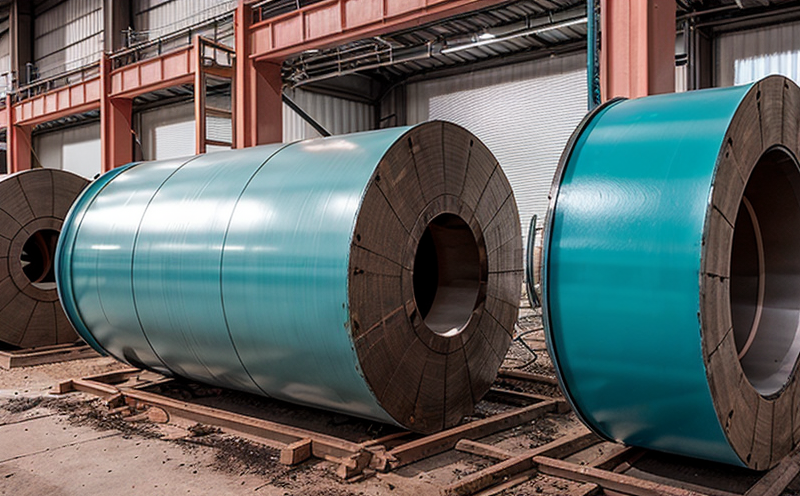ISO 20568 Corrosion Testing of Metallic Materials in Sea Water
The ISO 20568 standard specifies a procedure for assessing the resistance to corrosion of metallic materials, particularly those used in maritime environments. This testing is critical for industries that operate in coastal or marine settings, such as shipbuilding, offshore oil and gas, and naval engineering. The test simulates exposure to sea water conditions, which can be highly corrosive due to its salt content.
The procedure outlined in ISO 20568 involves immersing metallic specimens in a sea water solution for an extended period under controlled conditions. This allows for the assessment of the material's resistance to corrosion by measuring weight loss, surface changes, and other indicators of degradation. The test is particularly relevant for materials that are exposed to salt spray or immersion in seawater.
The standard provides detailed instructions on how to prepare specimens for testing, including dimensions, surface finish, and orientation within the sea water bath. It also specifies the duration of exposure and the methods for evaluating corrosion resistance. Compliance with ISO 20568 can be a crucial factor in selecting materials for marine applications where prolonged exposure to harsh environments is inevitable.
In addition to its role in material selection, ISO 20568 testing plays a vital part in quality assurance programs by ensuring that the materials used meet the necessary standards. This test helps manufacturers and suppliers demonstrate their commitment to producing reliable products capable of performing under challenging environmental conditions.
The results of ISO 20568 tests are often used as part of broader material specification documents, helping to ensure consistent performance across different projects or applications. For instance, in the offshore oil industry, materials that pass these rigorous tests can be more confidently deployed without fear of premature failure due to corrosion.
Moreover, ISO 20568 testing supports sustainability goals by enabling industries to make informed decisions about material selection, thereby reducing waste and ensuring long-term durability. By choosing materials that demonstrate excellent corrosion resistance through this standardized test, companies can extend the operational life of their equipment and infrastructure, minimizing replacement costs and environmental impact.
Understanding the scope and application of ISO 20568 is essential for those involved in industrial manufacturing and processing who need to ensure compliance with international standards. This testing procedure provides a robust framework for evaluating metallic materials' suitability for marine environments, ultimately contributing to safer and more sustainable engineering practices.
Why Choose This Test
- Comprehensive Evaluation: ISO 20568 provides a comprehensive approach to evaluating the corrosion resistance of metallic materials in simulated sea water conditions, offering insights into material performance under real-world stressors.
- Standardized Methodology: The test follows internationally recognized standards, ensuring consistency and reliability across different testing facilities.
- Industry-Wide Acceptance: Compliance with ISO 20568 is widely accepted in the maritime industry, enhancing a company's reputation for quality and compliance.
- Durability Assurance: By identifying materials that can withstand harsh marine environments, this test helps ensure long-term durability of products used in critical applications such as shipbuilding and offshore infrastructure.
- Sustainability Focus: The test supports sustainability initiatives by promoting the use of durable materials that reduce maintenance costs and environmental impact.
- Quality Assurance: ISO 20568 testing is an integral part of quality assurance programs, helping to maintain high standards in product design and manufacturing processes.
Environmental and Sustainability Contributions
The implementation of ISO 20568 corrosion testing contributes significantly to environmental sustainability by promoting the use of durable materials that reduce waste. By selecting materials that demonstrate excellent corrosion resistance, industries can extend the operational life of their equipment and infrastructure, thereby minimizing replacement costs and reducing the need for frequent repairs.
In addition to cost savings, this approach has a positive impact on the environment by decreasing the frequency of replacements, which in turn reduces the amount of waste generated. The use of durable materials also helps minimize the carbon footprint associated with manufacturing new products, as it requires fewer resources and energy inputs over the product lifecycle.
The test procedure itself supports sustainable practices by providing a standardized method for evaluating material performance under harsh conditions. This ensures that only the most suitable materials are used in critical applications, reducing the likelihood of premature failure and subsequent environmental impacts from discarded equipment or infrastructure.
By adhering to ISO 20568 standards, companies can contribute to broader sustainability goals by promoting long-term durability and minimizing waste. The test not only enhances product performance but also supports environmentally responsible decision-making in industrial manufacturing and processing.
Use Cases and Application Examples
The ISO 20568 corrosion testing procedure is widely used across various sectors where materials are exposed to marine environments. Some key use cases include:
- Shipbuilding: Ensuring that the metallic components of ships can withstand long-term exposure to salt water.
- Offshore Oil and Gas: Evaluating the durability of equipment used in offshore platforms, which are often exposed to harsh marine conditions.
- Naval Engineering: Testing materials for use in naval vessels where prolonged immersion in seawater is expected.
- Marine Structures: Assessing the corrosion resistance of structural components in coastal or maritime environments.
In each of these applications, ISO 20568 testing provides critical data on material performance under specific conditions. This information is invaluable for quality managers and compliance officers who need to ensure that their products meet the necessary standards for use in marine environments.
For R&D engineers, ISO 20568 offers a valuable tool for developing new materials or improving existing ones by providing insights into how various factors affect corrosion resistance. For procurement departments, it ensures that suppliers provide materials that are not only cost-effective but also capable of withstanding the rigors of marine environments.
The test results can be used in conjunction with other quality assurance measures to ensure consistent performance across different projects or applications. By leveraging ISO 20568 testing, companies can make informed decisions about material selection and product design, ultimately contributing to safer and more sustainable engineering practices.





